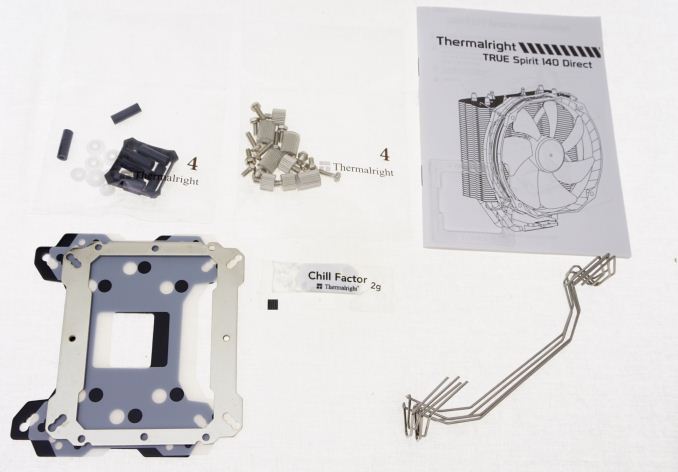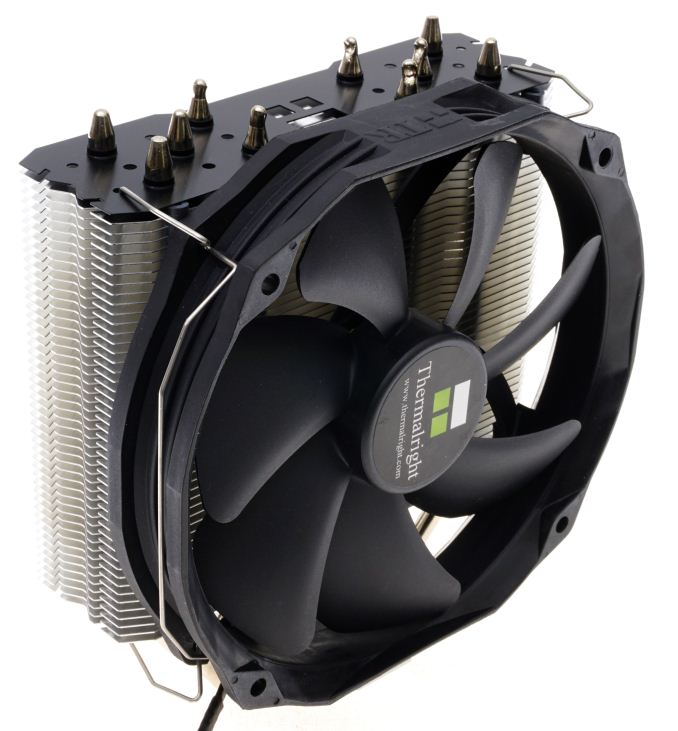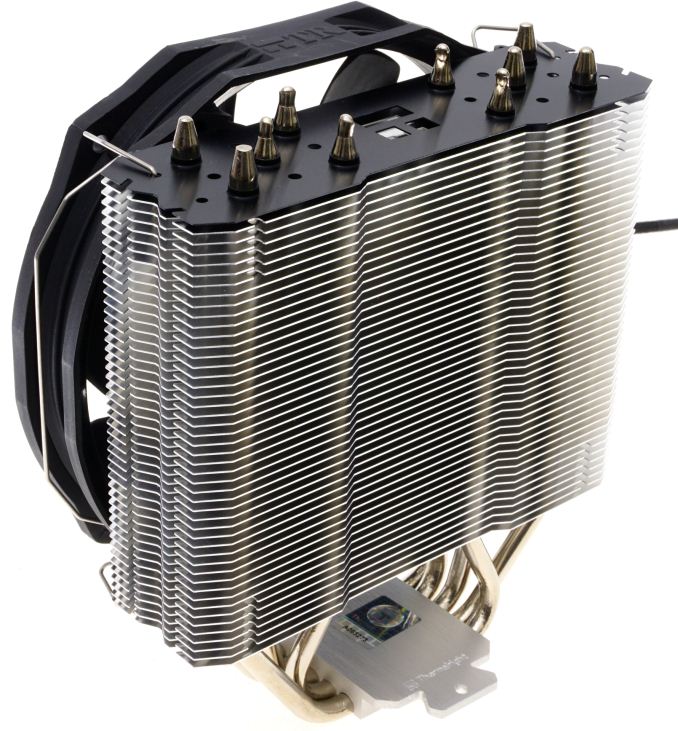The 140mm Slim Tower CPU Cooler Roundup: Thin & Light Done Just Right
by E. Fylladitakis on May 24, 2017 8:00 AM EST- Posted in
- Cases/Cooling/PSUs
- be quiet!
- Noctua
- Phanteks
- Cooler
- Thermalright
Thermalright True Spirit 140 Direct
Thermalright is practically a newcomer here in AnandTech, as we have not looked at any of their products since 2010 and our last Thermalright CPU cooler review is now nearly a decade old. The cooler that we will be reviewing today is the Thermalright True Spirit 140 Direct, the upgraded version of their popular Thermalright True Spirit 140 cooler. It comes supplied inside a dark box with minimal artwork, only a clear picture of the cooler itself and icon denoting its most important features.
Inside the box we only found the absolute necessary parts for the installation of the cooler, which are a one-fits-all backplate, mounting hardware, fan support wires, fan anti-vibration standoffs, and a small but detailed installation manual. Thermalright also supplies one dose of their “Chill Factor” thermal compound.
Much like Noctua’s and Be Quiet!’s offerings, the Thermalright True Spirit 140 Direct has a single 52 mm deep fin array with a 140 mm fan attached on it. The fin array is relatively simple, with only a recessed center area to reduce the aerodynamic drag noise. The top fin of the array has been painted black for aesthetic purposes. It has five 6 mm nickel-plated heatpipes.
Thermalright is using one of their TY-140 cooling fans on the True Spirit 140 Direct. The TY-140 is a PWM general purpose cooling fan that has been initially designed with 120 mm mounting holes to maximize compatibility. The company advertises its “Enhanced Hyper-Flow Bearing (EHFB)” engine as consistent and highly reliable, without any further information regarding its design and/or mechanics.
The fan mounting mechanism is strange, with the fan having to sit on rubber standoffs that need to be inserted into small cutouts on the fin array. It is not possible to mount the fan without these standoffs. Hopefully the rubber that they are made of will last for several years, but replacements may be necessary for people who keep their hardware for more than a few years or if they are lost. (Tip: Pieces of large drinking straws do work as a temporary solution)
The large difference between this cooler than the others in this roundup review (and also its major upgrade over the previous version) is the design of its base. Instead of having a contact plate coming in contact with the CPU and the heatpipes attached to it, the heatpipes of the True Spirit 140 Direct are in direct contact with the CPU itself. The top part of the base is made of machined aluminum and only provides mechanical cohesion and retention bracket support.
















74 Comments
View All Comments
guidryp - Wednesday, May 24, 2017 - link
IMO, it looks like the Thermalright is the the winner. It's the least expensive, and up to 150 watts, it keeps the lowest temperature. How many CPUs pull over 150 watts? Especially in real world workloads, not torture testing??JoeyJoJo123 - Wednesday, May 24, 2017 - link
That would seem to be the case here, yes. Performs as well as the Noctua (better than the Noctua at low loads and nearly equal at high loads), while being physically smaller, and cheaper, too.The black and silver finish is relatively attractive, too, but appearances are subjective anyways.
A5 - Wednesday, May 24, 2017 - link
Agreed, and I own the Noctua.I've had Thermalright products in the past and they were excellent as well.
ShieTar - Wednesday, May 24, 2017 - link
That only remains true if the CPU produces power over the same area as the thermal cartridge used in the test. The problem, specifically with Intels latest 4-Cores, is that they generate 100W on a much smaller area. Then the overall cooling capability and the vertical thermal resistance of the cooler become less relevant, and the lateral thermal resistance of the cooler base-plate becomes increasingly critical. That is why an i7-7700K will run much hotter than older CPUs with the same TDP, but much more die area.JoeyJoJo123 - Wednesday, May 24, 2017 - link
You're not wrong, but there's more to that story.It's also partially attributable to Intel's usage of poor TIM between the die and the integrated heatspreader, rather than their older usage of fluxless solder.
Intel's newer chips (due to smaller die sizes and poorer thermal interface for the integrated heatspreader) means that by the time the heat meets the heatsink vs integrated heatspreader contact area, it's not being dissipated as efficiently as older CPU models.
guidryp - Wednesday, May 24, 2017 - link
I think you have the situation backwards. The way the Thermalright excels at lower temperatures and it's direct heatpipe design indicate it has superb transfer from the socket.It only falls behind later when when the smaller heatsink array can't dissipate it as quickly.
Eri Hyva - Wednesday, May 24, 2017 - link
Please, add a test with 9 volts.Arbie - Wednesday, May 24, 2017 - link
Other sites reviewing coolers (eg X-Bit Labs R.I.P.) have found ways to plot cooling ability vs noise level. That makes it much easier to evaluate and choose the best one. IIRC one site even got cost into the same picture. In any case, leaving the reader to separately juggle delta-T and dBA is weak.Galcobar - Thursday, May 25, 2017 - link
Gold standard for standardized testing the efficiency of noise to cooling is Silent PC Review.Unfortunately, the site suffered a serious lack of ad revenue and seemed to go into the media death spiral of lack of readership>lack of revenue>lack of content>lack of readership. Hasn't been a posting since August.
snarfbot - Wednesday, May 24, 2017 - link
Well the article measures perf as shipped which while good is not apples to apples as they all use diff fans. They should be measured separately with the same fan installed into each to take fan speed, voltage and noise out of the equation.